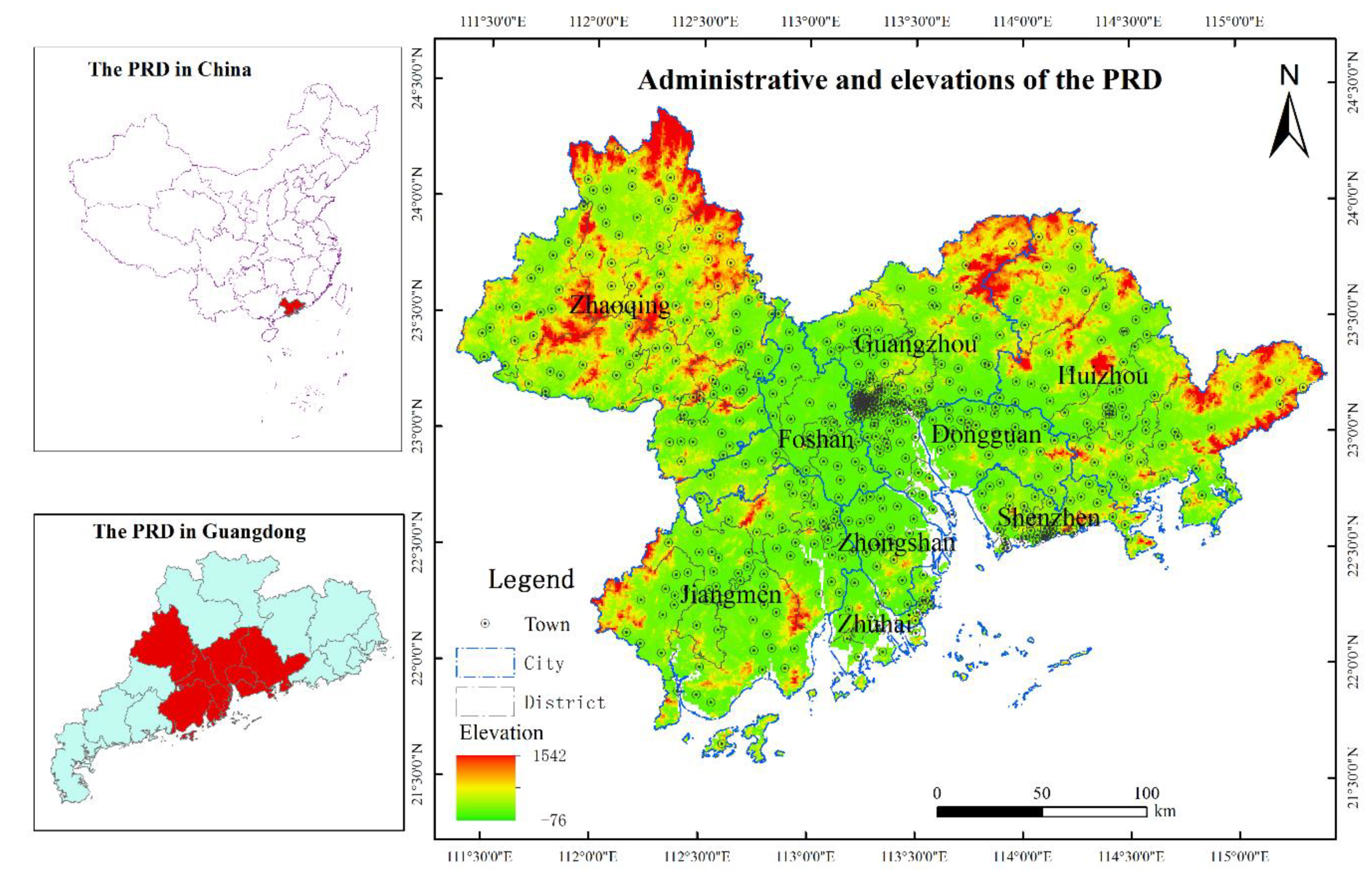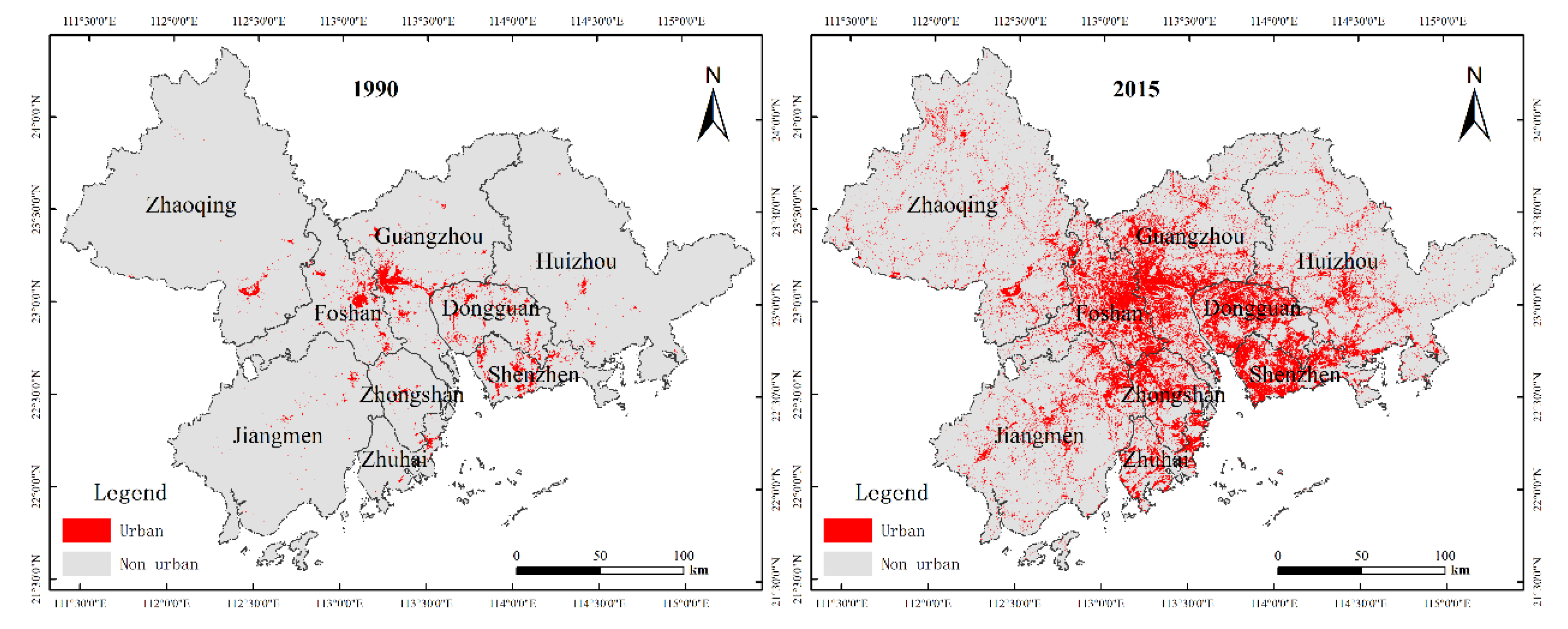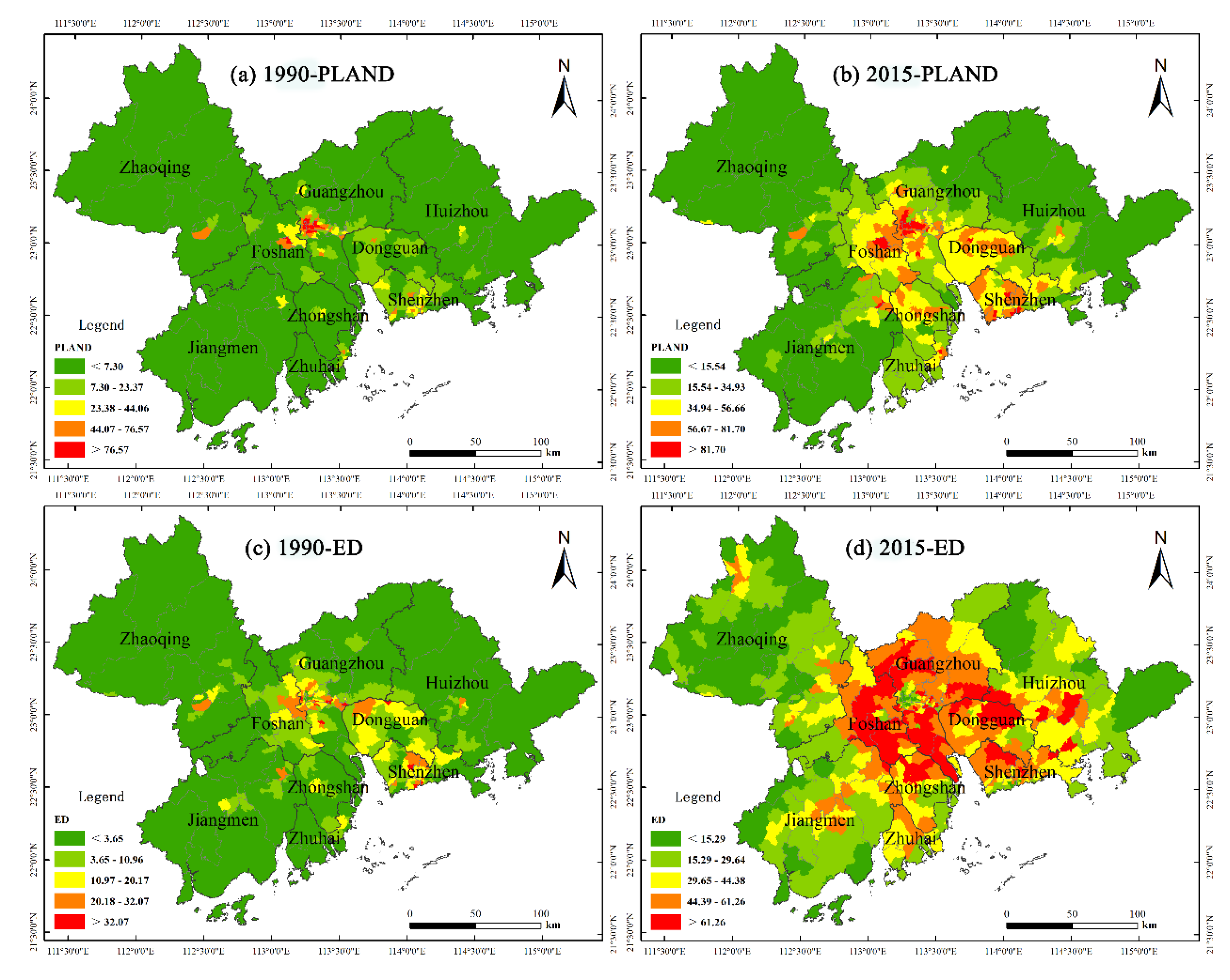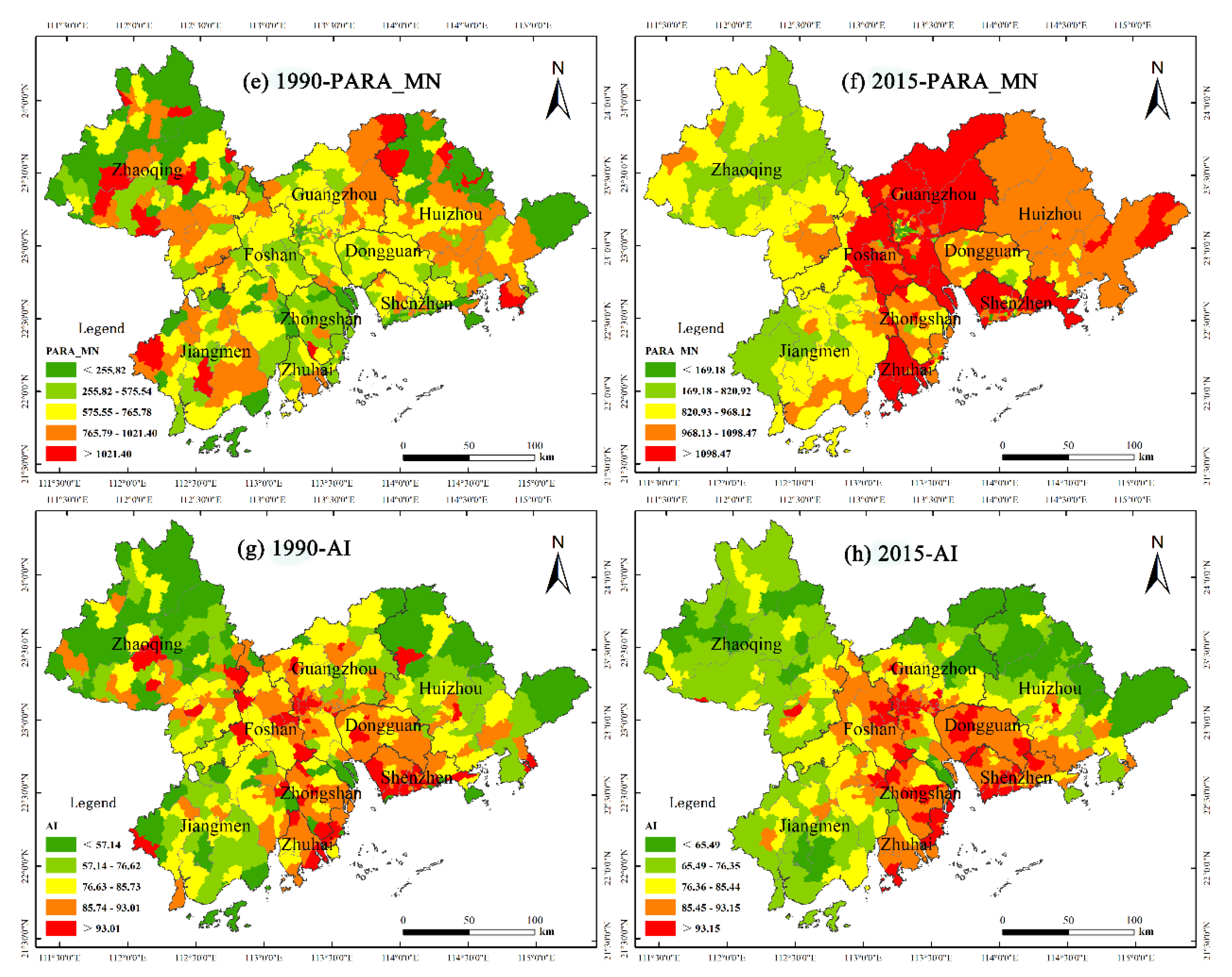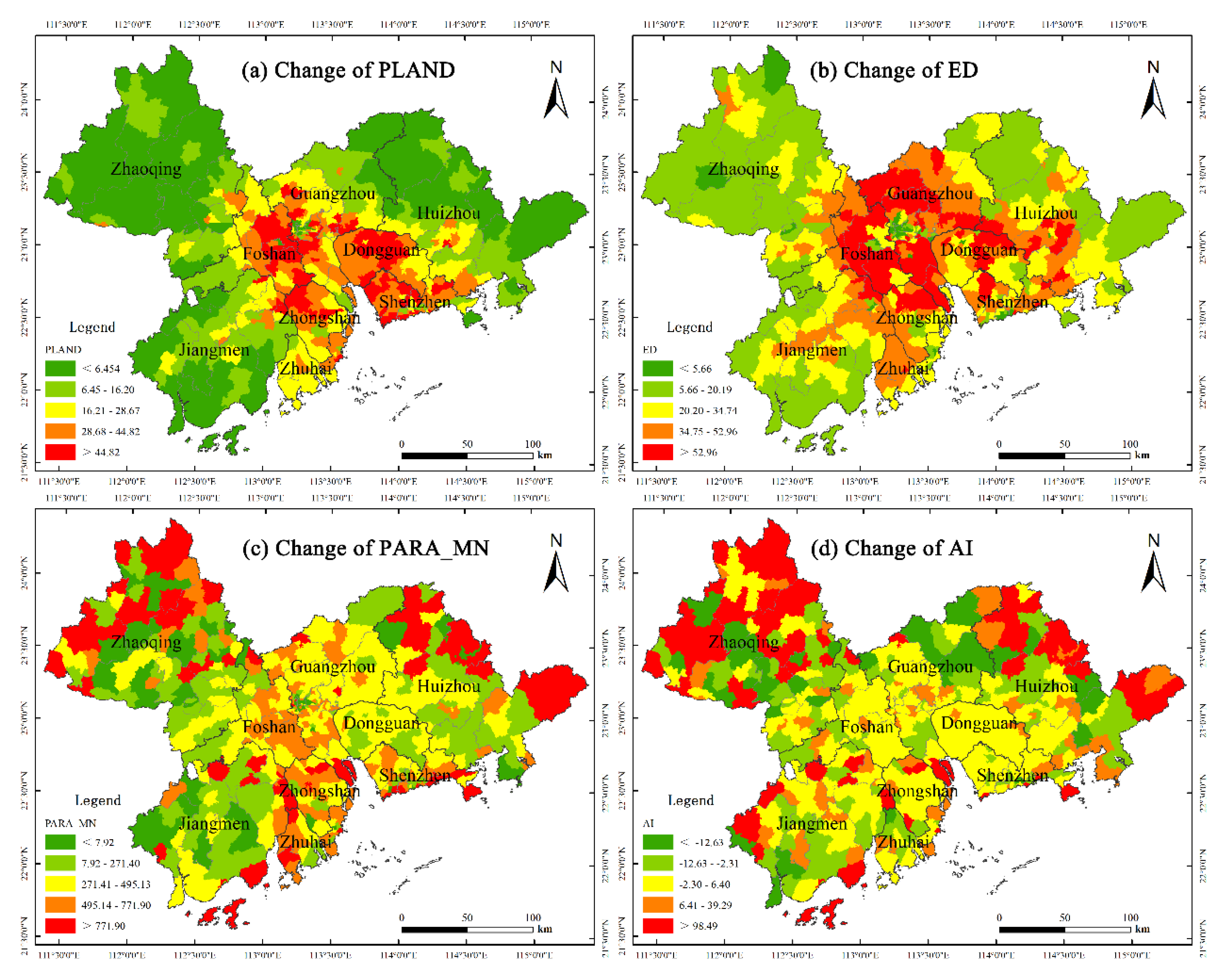3.1.1. Spatial Patterns of Built-Up Landscape Changes
As shown in
Figure 2, the area of built-up land in PRD had increased rapidly from 1202.87 km
2 in 1990 to 9127.09 km
2 in 2015. The growth in built-up land by 7924.22 km
2 in 25 years means that the average annual growth rate was at 26.35%.
The summary of the results of the built-up landscape analysis using FRAGSTATS4.2 (University of Massachusetts in Amherst, Amherst, MA, USA) is shown in
Table 2. The percentage of built-up land (PLAND) increased from 2.21 in 1990 to 16.69 in 2015, indicating continued urbanization in the study area. Edge density (ED) surged from 2.31 in 1990 to 31.07 in 2015, indicates the ratio of the total edge length of all built-up land patches over the total landscape area have substantially improved, mean that the level of fragmentation have improved from 1990 to 2015. which suggests that the degree of fragmentation have substantially improved. The perimeter-area ratio_mean (PARA_MN), which is indicative of shape complexity, also increased in value, suggesting that urban spread has become more complex. In terms of aggregation index (AI), the value decreased marginally from 91.37 in 1990 to 86.04 in 2015, which implies slight changes have occurred on the aggregated distribution of built-up lands. In summary, at the landscape-level, the extent of built-up land had increased significantly, fragmentation intensified, distribution characteristics became more complex, while the degree of aggregation declined.
The landscape metrics of the 581 towns in PRD were calculated at the class-level (a specific type of land use) for 1990 and 2015, and the results are presented in
Figure 3. In 1990 (see
Figure 3a), built-up land patches are mainly located in the central towns of large, populated cities, such as Guangzhou and Foshan. In 2015 (see
Figure 3b), areas with high proportions of built-up land increased significantly and extended to other cities, such as Dongguan, Shenzhen, and Zhongshan. In terms of edge density, the areas with high edge density values in 1990 (
Figure 3c) were limited and were concentrated mainly in small towns in Guangzhou, Foshan, Dongguan, Shenzhen, and Zhuhai. In 2015, the spatial concentration demonstrated became more evident, with areas having high edge density values expanding towards the periphery (see
Figure 3d). Thus, a distribution trend of edge values becomes more evident wherein high values are concentrated in core areas and gradually decrease into the margins. In terms of the perimeter-area ratio_mean, the dispersion was more widespread, and there were no clear town having extremely high values for 1990 (
Figure 3e). For 2015, the areas with high mean ratio values significantly proliferated and shifted towards the central areas of PRD and can be found mainly in the cities of Guangzhou, Foshan, Zhuhai, and Shenzhen (see
Figure 3f). A distribution pattern has formed where the values at the eastern bank of the Pearl River Estuary are considerably larger than those in the western bank. In terms of aggregation index, there are no observable regular distribution features found for 1990 (
Figure 3g); but in general, the high values can be found in the city center. For 2015, the values are shown to gradually decrease from the core areas on both sides of the Pearl River Estuary towards the peripheral areas (
Figure 3h).
To further evaluate the changes in landscape patterns occurring in the cities, the spatial distribution diagrams of the landscape metrics were generated using Equation (4), and are shown in
Figure 4. Based on the results, the distribution trends of
(
Figure 4a) and
(
Figure 4b) exhibit similar features, where the values in the core areas are much larger than those in the peripheral areas, and the values in the east and west sides of the Pearl River Estuary obviously higher than other regions. The distribution trends of
(
Figure 4c) and
(
Figure 4d) share similar features, the peripheral areas have towns with both high and low values. For example, towns in Jiangmen have relatively low values, while in Zhaoqing and Huizhou, the values are relatively high.
Based on the analyses of results, the area, shape, fragmentation degree, and aggregation state of built-up land have changed significantly from 1990 to 2015. In particular, the extent of the built-up area is increasing, the shape is becoming more complex, the level of fragmentation is becoming higher, and the aggregation degree is declining. Furthermore, the changes in landscape metrics have significant spatial distribution heterogeneity in the core and peripheral towns of cities and in the different regions of PRD. With regard to city-level changes in the built-up landscape metrics, the values of and are high in the core areas and low in the peripheral areas There are also no apparent distribution features in and , but with significant differences between core and peripheral areas. The reason for the differences is that the built-up lands are mainly concentrated in the central towns of cities and in the PRD’s core area. In some areas in the core towns, the proportion of built-up lands reaches 80% or higher. Thus, the growth disparity between peripheral and core areas gradually narrowed as urbanized lands expanded, forming the spatial distribution and change pattern of built-up land features in the PRD.
3.1.2. Spatial Autocorrelation Analysis of Built-Up Landscape Pattern
Spatial autocorrelation analysis is used to further analyze the landscape patterns of built-up land expansion. Using the Geoda 1.14 software (GeoDa Center for Geospatial Analysis, Chicago, IL, USA), the values of Moran’s I were calculated for 1990 and 2015. The results, which are shown in
Table 3, indicate that all the metrics pass the hypothesis test with the significance level of 0.05.
All the Moran’s
I values in
Table 3 are positive, which means that
L1990,
L2015, and
L2015 − L1990 all have positive spatial autocorrelation. Towns with high values tend to be adjacent to other towns with high values, and likewise, towns with low values are often adjacent to low-value towns. The Moran’s
I values in
L2015 are larger than in
L1990. The spatial autocorrelation of PARA_MN and AI increased considerably while the spatial autocorrelation of PLAND and ED remained relatively stable and only increased slightly. The Moran’s
I values of
L2015 − L1990 are also large, indicating positive spatial autocorrelation with evident spatial agglomeration characteristics. The Moran ’s
I values of
and
are significantly larger than the values of
and
.
In order to determine spatial agglomeration areas experiencing landscape changes of built-up lands, Geoda 1.14 software (GeoDa Center for Geospatial Analysis, Chicago, IL, USA ) was used to calculate the local spatial autocorrelation indexes of
,
,
, and
. After applying the LISA clustering map, non-significant types were found to be the predominant type, the High-High and Low-Low towns were numerous, and the High-Low and Low-High towns were minimal. For
(
Figure 5a), there are 295 non-significant type areas, 114 High-High clusters concentrated around the core areas of the east and west banks of the Pearl River Estuary, 165 Low-Low areas mainly distributed in the peripheral areas of PRD (e.g., Zhaoqing, Huizhou, and Jiangmen), and six Low-High and one High-Low towns scattered mainly in the surrounding areas of High-High type towns (such as in Guangzhou and Shenzhen). For
(
Figure 5b), there are 383 non-significant type areas, 96 High-High clusters distributed around the central regions of the PRD (such as in Guangzhou and Foshan), 96 Low-Low clusters concentrated in Zhaoqing, and four Low-High and two High-Low towns found mainly in Guangzhou and Foshan. For
(
Figure 5c), there are 443 non-significant type areas, 41 High-High clusters dispersed in Zhongshan, Zhuhai, Zhaoqing, and Huizhou, 59 Low-Low clusters mainly located in the cities of western PRD including Zhaoqing and Jiangmen, 14 Low-High areas in Huizhou and Zhongshan, and 24 High-Low towns situated primarily in Zhaoqing and Jiangmen. For
(
Figure 5d), there are 485 non-significant type areas, 35 High-High areas distributed in northwest Zhaoqing and northeastern Huizhou, 33 Low-Low towns dispersed all over the region with a small concentration found in northern Guangzhou, 22 Low-High and six High-Low towns, and the Low-High type distribution is similar the High-High type and distributed mainly in the northwest of Zhaoqing and the northeast of Huizhou, and six High-Low towns mainly distributed in the peripheral areas of the cities of Zhaoqing, Huizhou, and Jiangmen.
The analyses show that significant spatial agglomeration exists in the landscape metrics, and the patterns in the changes of built-up lands are becoming more pronounced. The analyses on the clustering maps for , , , and show that there are more High-High and Low-Low areas compared with High-Low and Low-High towns, and there is significant spatial differentiation feature in the core and peripheral areas of the PRD.
